GOING LIVE ON SIVARATHRI
Sai Ram, Dear Reader!
I hope you are aware that this year, the Sivarathri proceedings
were telecast live in India for three hours, from 5 PM to
8 PM. The editorial in an earlier issue made a mention of
this. It was an amazing experience, considering that none
of us have had any experience of this sort thing before. But
then, that is the way things happen in Swami’s Mission.
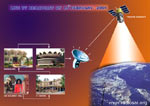 The
idea of a live telecast took root some months earlier when
an effort was made to webcast, in a limited way that is, the
last day of the Dasara proceedings.
That is the day when the seven-day Yajna
is brought to a grand finale in the Poorna
Ahuti function. This webcast was not really done by
us but by another group, and we merely provided a camera signal.
The webcast was quite limited in scope, and to just the city
of Madras/Chennai, where thousands of devotees gathered in
the Sai Centre Sundaram saw live what was going on. The
idea of a live telecast took root some months earlier when
an effort was made to webcast, in a limited way that is, the
last day of the Dasara proceedings.
That is the day when the seven-day Yajna
is brought to a grand finale in the Poorna
Ahuti function. This webcast was not really done by
us but by another group, and we merely provided a camera signal.
The webcast was quite limited in scope, and to just the city
of Madras/Chennai, where thousands of devotees gathered in
the Sai Centre Sundaram saw live what was going on.
Came Birthday, and by now we were in the picture. This time,
we taped the function, and later did a webcast in the evening
for devotees in Sundaram, Madras, and subsequently to the
US where the webcast was seen by many groups there. Of course
it was a delayed webcast, but the viewers saw it within hours
of the event and at a convenient time too, that is in the
evening.
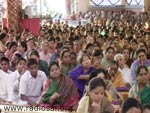 One
more practice round of web streaming to the US and this was
during Christmas. This too went off well. So much so, when
Prof David Gries of Cornell University came here in early
January for his annual stint of teaching in Swami’s
Institute, we got together and worked out a road map for starting
regular streaming service internationally, even as we now
have international radio streaming service. One
more practice round of web streaming to the US and this was
during Christmas. This too went off well. So much so, when
Prof David Gries of Cornell University came here in early
January for his annual stint of teaching in Swami’s
Institute, we got together and worked out a road map for starting
regular streaming service internationally, even as we now
have international radio streaming service.
By this time,
the Sivarathri fever was mounting, and Mr. Gopal Srinivasan
who through his continued munificence has been driving many
of our technical developments said: “Listen, you are
already telecasting three times a week a TV program called
SPIRITUAL BLOSSOMS FROM PRSHANTI NILAYAM on Sanskar TV channel.
It is quite popular and eagerly looked forward to by thousands
all across the country. Why not go live on SR day? In fact,
we must!” One thing led to another and Gopal sought
the Divine blessing, which was given. From that moment, there
was no turning back.
So what does a live telecast mean and what
arrangements did we have to make? Quite a lot. First and foremost,
we had to line up four cameras to cover the scene. Fortunately,
we now have four good digital cameras and  we
managed to identify four choice locations that would enable
us to have good video coverage. Next, we had to pipe the signals
to a central control centre, complete with monitors. Seated
at the control centre were three persons, one of whom was
the Director. The second person controlled the video mixing
and the third controlled the audio level. This was not enough.
We had to provide a talk-back system so that everyone could
communicate with everyone else. This was a hands-free system,
the sort pilots wear while piloting an aircraft; that is to
say, there are headphones, and a small attached mike. The
Control system was established inside the Mandir, yes, the
place where normally we have Bhajans, with Swami sitting in
His chair. On an earlier occasion, to be precise on Birthday
of 2002, we did a live radio broadcast over Radio Sai. On
that day too we had set up our control facilities [much smaller
than this time] inside the Mandir. And you know what? After
the morning functions were over, Swami suddenly came inside
the Mandir and He was quite surprised to see a whole lot chaps
who normally are not found there! There was a sort of quizzical
look in His eyes, and He just walked away. We were all terribly
scared! So this time, I took the precaution of telling Swami
several times in advance that we would be working from inside
the Mandir. Not only that, we all had special photo-badges
that said in big bold letters: MANDIR DUTY. we
managed to identify four choice locations that would enable
us to have good video coverage. Next, we had to pipe the signals
to a central control centre, complete with monitors. Seated
at the control centre were three persons, one of whom was
the Director. The second person controlled the video mixing
and the third controlled the audio level. This was not enough.
We had to provide a talk-back system so that everyone could
communicate with everyone else. This was a hands-free system,
the sort pilots wear while piloting an aircraft; that is to
say, there are headphones, and a small attached mike. The
Control system was established inside the Mandir, yes, the
place where normally we have Bhajans, with Swami sitting in
His chair. On an earlier occasion, to be precise on Birthday
of 2002, we did a live radio broadcast over Radio Sai. On
that day too we had set up our control facilities [much smaller
than this time] inside the Mandir. And you know what? After
the morning functions were over, Swami suddenly came inside
the Mandir and He was quite surprised to see a whole lot chaps
who normally are not found there! There was a sort of quizzical
look in His eyes, and He just walked away. We were all terribly
scared! So this time, I took the precaution of telling Swami
several times in advance that we would be working from inside
the Mandir. Not only that, we all had special photo-badges
that said in big bold letters: MANDIR DUTY.
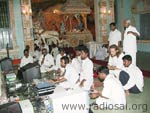 The
arrangements did not stop here, and there were a number of
other things that had to be done. We had already laid a fibre-optic
line from the Mandir to our nerve centre in the IT Centre
[we have described the inauguration of the IT Centre in an
earlier issue of H2H]. This cable would carry the composite
audio-video computer signal to the IT Centre, from where it
would go by a leased 2 MBPS line to Bangalore. This line is
available to us all the time and used by many here. However,
for this function, we blocked all other users at our end. The
arrangements did not stop here, and there were a number of
other things that had to be done. We had already laid a fibre-optic
line from the Mandir to our nerve centre in the IT Centre
[we have described the inauguration of the IT Centre in an
earlier issue of H2H]. This cable would carry the composite
audio-video computer signal to the IT Centre, from where it
would go by a leased 2 MBPS line to Bangalore. This line is
available to us all the time and used by many here. However,
for this function, we blocked all other users at our end.
Bangalore was not our destination but Bombay/Mumbai. Sanskar
does its uplink in Bombay, to the THAICOM satellite, which
then beams the signal down on the country. So we had to lease
a 2 MBPS line from Bangalore to Bombay. Thus, our signal was
supposed to go from Prashanti Nilayam first to Bangalore and
thence from there to Bombay.
All this sounds very simple and straight forward on paper
but in practice, it turned out to be quite tricky. The first
thing we realised was that when a service provider says that
he is offering a 2 MBPS line, we ought not to take it literally;
there is a lot of fine print, and in actual practice the throughput
turns out to be much lower. We could not get anything more
than 500 KBPS, which meant that the picture quality would
take a beating. We discovered this to our horror while doing
some preliminary trials. It was just about 10 days or so to
D Day, and we had not yet established a firm link to Bombay.
By the way, we from Prashanti Digital Studio were doing all
the ground work here in Prashantinilayam, while Mr. Ramesh
Babu, a senor associate of Mr. Gopal Srinivasan, did all the
technical liaison at the uplink station in Bombay. Here I
should not forget to mention the excellent logistic support
given to Ramesh by devotees in Dharmakshetra – without
the Sainet, the internet is nothing!
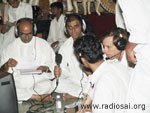 OK,
we were bowled out in the first round on this link from Bangalore
to Bombay. How did we come through? This is where the yeoman
work done by Ramesh needs special mention. He huddled with
the technical experts of the service provider, and arranged
what was constantly referred to as a “tunnel”
on the communication link. Frankly, I don’t quite know
what this tunnel is but believe me, it sure did make us see
the proverbial light at the end of the tunnel! OK,
we were bowled out in the first round on this link from Bangalore
to Bombay. How did we come through? This is where the yeoman
work done by Ramesh needs special mention. He huddled with
the technical experts of the service provider, and arranged
what was constantly referred to as a “tunnel”
on the communication link. Frankly, I don’t quite know
what this tunnel is but believe me, it sure did make us see
the proverbial light at the end of the tunnel!
The clock was ticking and we were inching towards D Day.
While things were generally under control back here, there
was still a lot of nail-biting going on regarding the Bangalore-Bombay
link.
Tests were being done all the time, and slowly our figure
crept up to 1 MBPS and thence on to 1.2MBPS audio signal included.
We were streaming video signals all the time from Prashanti
Studio to Bombay and found that 1.2 MBPS was the best we could
get. It was a take-it-or-leave-it situation. We just grabbed
it – no other choice, since the expectations of viewers
had been raised sky high. What about picture quality? Not
bad; quite good; not the very best but OK.
Three days before D day, at midnight, a 20 minute program
on tape was streamed from our Studio and actually telecast!
This was a trial. We taped the program as received in TV receiver,
and things seemed to be OK. We were now beginning to feel
more confident.
D Day minus
one, that is, Tuesday, 17th February. On Tuesdays, there is
a regular Sanskar telecast of our program at 9 PM. We had
already sent the digital tape for this program to Sanskar
TV ten days earlier [by courier] but decided to try out a
live telecast from our studio. It was done but there were
one or two minor glitches. One of these had to do with getting
the proper signal from Bombay for us to switch on and come
on the air. To be more precise, the countdown procedure we
had adopted earlier was forgotten! The glitches were minor
but they taught us a lesson for the next day.
Finally, the big day was here! From three days or rather
nights before this, our boys and several people here who were
helping, were slogging, and believe me it was truly hectic.
For not only were we telecasting live but we were also providing
video viewing in and around the Sai Kulwant Hall. We had established
120 TV monitors on CCTV network so that everyone in every
nook and corner of Sai Kulwant Hall could watch the proceedings
comfortably. Besides this, four big screens had been set up
to enable people gathered on roads also to watch. All this
was done to prevent the crowd surges that were witnessed in
earlier years. It was a lot of work but it paid off. One elderly
lady whom I met after the event said that thanks to CCTV she
was able to sit comfortably in the Poornachandra Hall and
witness the proceedings – yes there were 20 monitors
in the PC Hall too! By Swami’s Grace we were able to
offer this unique service which has never been done before.
What I am trying to convey is that there was a lot we had
to do and there was practically no rest during the preceding
four days and nights – they were absolutely hectic.
Please understand, we had to work within very restricted slots,
that is, a couple of hours in the afternoon between end of
morning Darshan and commencement of evening Darshan. And that
meant, most of the work had to be done at night.
Oh yes, I should not forget to mention that we had to set
up a TV antenna on top of the Mandir. This was a tricky business
because Mandir access is highly restricted especially on account
of security. Finally, we got the antenna and the receiver
going at 1 AM on Tuesday morning! By the way, connecting 120
TV sets by cable is no joke; one crew was working on this
for three nights, for that is when they could work. I hope
all this gives you some idea of the slogging that has to go
on in the background.
 Finally,
D Day! The morning function was over and it was announced
that the evening function would commence at 4 PM. We were
all in the Mandir by 2 PM, tense, anxious and biting our nails,
figuratively that is! Though we were to go on air at 5 PM,
we started the streaming trials from 3 PM itself just to make
sure all the necessary adjustments at the Bombay end could
be done in advance. This was one of the lessons we had learnt
from earlier trials. We had mobiles all over the place and
were in constant touch with Bombay. We worked out a count
down procedure – 30 seconds before air time, a person
from Bombay would tell us, “You will be on air 30 seconds
from now.” At 20 seconds he would say, “20 seconds
to go!” Meanwhile, we were watching the regular Sanskar
program on a TV tuned to receive that channel. Imagine that!
A TV set inside the Mandir!! We had to keep an eye on our
monitors also. Finally,
D Day! The morning function was over and it was announced
that the evening function would commence at 4 PM. We were
all in the Mandir by 2 PM, tense, anxious and biting our nails,
figuratively that is! Though we were to go on air at 5 PM,
we started the streaming trials from 3 PM itself just to make
sure all the necessary adjustments at the Bombay end could
be done in advance. This was one of the lessons we had learnt
from earlier trials. We had mobiles all over the place and
were in constant touch with Bombay. We worked out a count
down procedure – 30 seconds before air time, a person
from Bombay would tell us, “You will be on air 30 seconds
from now.” At 20 seconds he would say, “20 seconds
to go!” Meanwhile, we were watching the regular Sanskar
program on a TV tuned to receive that channel. Imagine that!
A TV set inside the Mandir!! We had to keep an eye on our
monitors also.
There was a slightly tricky element here. You see that though
TV signals travel with the speed of light, there is a 10 second
delay in the conversion of our camera signal into a computer
signal ready for transmission. Thus our signal reaches Bombay
10 seconds after our cameras produce them. Next, at Bombay
end there is another delay of 10 seconds before our signal
goes through the computer there to the satellite. So, in the
end, there is a 20 second between what people in SK hall see
and what people see on their TV screens. We had to keep that
in mind. In other words, we had to start 20 seconds before
the preceding TV program ended. By Swami’s Grace and
mobile phones and all that, we did it perfectly, and the net
result was there was absolutely no blank screen. When the
previous TV program ended, ours came on just like that! Boy,
were we relieved!
The story does not quite end here; in fact this is where
it really begins. What did we show? Well, we did not exactly
cut to SK Hall; we had a nice prologue that introduced the
viewer to what Sivarathri is all about, the spiritual significance,
the folklores associated with it etc. Also some vintage shots
from yesteryears. All this was for about 20 minutes.
At the end of the prologue, the commentators took over and
we cut to SK Hall to show the proceedings as they were taking
place there. We had an old student of ours who took care of
the English commentary while for Hindi we had two persons.
We deliberately gave a lot of importance to Hindi because
we had a huge segment of viewers in the North where Hindi
is understood better. The Hindi commentary was handled by
a devotee and a professional sent us to from Bombay.
While we were on air, we had to constantly
be alert, not only with respect to the telecast but also with
respect to local problems. For
example, soon after went on air, we discovered that despite
all earlier trials and setting adjustments, the sound as received
on the TV receiver was not good; there was some jarring sound.
So Bombay had to be informed and adjustments made there. I
had to run here and there and cueing people as needed. Especially
with respect to the commentary, I had to signal these people
what to say and when. The commentators were a bit uncomfortable
to start with because they had to sit on the floor and there
was a terrific ambient noise from the Public Address system.
But we had to live with it. But this was not the end of our
problem. People walked in and out of the Mandir as they pleased.
For example just after Swami left, which was at about 7 PM,
a large number of people started coming into the Mandir. They
all wanted to worship there! I had a tough time keeping them
out. They just would not understand that we were doing a live
telecast and needed quiet! Almost everyone looked daggers
at me even while I tried to function like a bouncer! Finally,
I managed to bolt the door but my problems were not over;
the Chief Minister of one State who had come was now making
his exit and his Security wanted to use the Mandir as the
gateway. So all these gun-toting chaps had to be let through!
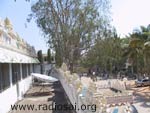 OK,
were our problems over? By no means! The moment Swami left,
people just started getting up and leaving. I mean, how could
we show thousands getting out! What would people outside think?
This is where forward planning helped. We had ready, stuff
taped from the morning. We just switched to that and the commentators
were now allowed to have a field day. They were now in their
elements and enjoyed every minute of it. OK,
were our problems over? By no means! The moment Swami left,
people just started getting up and leaving. I mean, how could
we show thousands getting out! What would people outside think?
This is where forward planning helped. We had ready, stuff
taped from the morning. We just switched to that and the commentators
were now allowed to have a field day. They were now in their
elements and enjoyed every minute of it.
What about the high-point, that is, the Lingodbhavam? Well,
we had done a lot of planning about that. We had arranged
for each cameraman to send his tape immediately after the
event to the control room. Here we were supposed to do the
replay. Unfortunately since we did not have proper tape recorders,
we used DV Cameras for that purpose, four of them! But it
worked, and people all over the country saw the Lingodbhavam
replays several times, in slow motion too.
A couple of juicy stories! During the telecast, one person
came running from the SK Hall screaming, “CCTV off in
our sector! Do something immediately!!” Crisis management!
We sent a person and he found that when a fat devotee sat
on it, the cable snapped! So the cable had to be repaired
on the spot. Lesson – bury the cable! Hope to do that
this summer when Swami is away!
Another incident. Suddenly, just before start
of the afternoon proceedings, we hear that a team from a reputed
TV news channel was here and had been permitted to video tape
the event. We had worked out with security a spot for them
to shot from. But you know what? These media people [there
was one more from Delhi] are not only professional but very
used to having their own way. So, they came, and said, “We
don’t like this spot,” came to where our camera
was, and just moved it aside! It was like a Western and we
were getting pushed around in our own backyard! I had to rush
and do some mediation, practicing all the virtues taught by
Swami – this is when bookish knowledge had to be quickly
translated into practical knowledge!
There were happier moments too. While the
telecast was going on, one person came to me and said, “Sir,
every shop in the village is showing the program and thousands
are watching”. Another excitedly told me, “My
wife who is in Calcutta called me just now on the mobile and
told me that it is fantastic.” This was most gratifying.
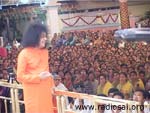 One
difficult moment. Just after Lingodbhavam, Swami suddenly
leaned forward and for a second it seemed as if He was far
from well. Knowing the anxiety this would cause to viewers,
Gene Massey who was at the Director’s control, quickly
switched to another camera view. Real fast thinking. We of
course saw it all but the viewers in the country saw it for
just a fraction of a second; but even that was enough for
it led to so many mails and phone calls. Anyway, Swami was
back in form in just five minutes and continued His Discourse.
After that He sat for Bhajans and left. And you know what?
He made a surprise visit at 1.40 AM. Attendance in the hall
was thin but those who were present, students mostly, sang
with fantastic gusto! There were no mikes and this was the
most robust singing one can ever witness. I have seen this
many times. Boy, do they beat the hell out of the drums to
keep everyone awake?! Swami enjoyed it immensely,
and luckily we have it all on tape. One
difficult moment. Just after Lingodbhavam, Swami suddenly
leaned forward and for a second it seemed as if He was far
from well. Knowing the anxiety this would cause to viewers,
Gene Massey who was at the Director’s control, quickly
switched to another camera view. Real fast thinking. We of
course saw it all but the viewers in the country saw it for
just a fraction of a second; but even that was enough for
it led to so many mails and phone calls. Anyway, Swami was
back in form in just five minutes and continued His Discourse.
After that He sat for Bhajans and left. And you know what?
He made a surprise visit at 1.40 AM. Attendance in the hall
was thin but those who were present, students mostly, sang
with fantastic gusto! There were no mikes and this was the
most robust singing one can ever witness. I have seen this
many times. Boy, do they beat the hell out of the drums to
keep everyone awake?! Swami enjoyed it immensely,
and luckily we have it all on tape.
And so, one more Sivarathri passes off into history. Perhaps
some of you may recall we offered excerpts from old issues
of Sanathana Sarathi in an earlier issue. Who knows? Decades
from now, what you now read may be offered for devotees of
that period in the same fashion!
Shakespeare said, “All that lives must die, passing
from here to Eternity.” Hemmingway wrote a book with
the tile “FROM HERE TO ETERNITY” which later became
a classic movie starring Frank Sinatra, Montgomery Clift and
several others. It also won Oscars I believe.
Why am I bringing this up? Because, at the basic level, Sivarathri
is a reminder of the journey from here to Eternity. From Eternity
we have come here; now that we are here, we must avoid being
trapped here for eternity through the ‘birth again,
death again’ syndrome! The eyes must be on the Road
to Eternity and not on the Road to Bali or Road to Rio [old
timers would know what I mean by this]!
Hope you liked this feature. Why don’t you write and
tell us what you think, even if it is not favourable?!
Jai Sai Ram.
G.VENKATARAMAN
|